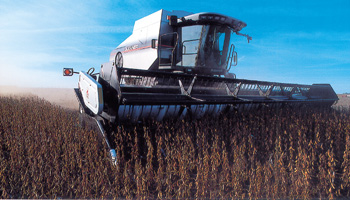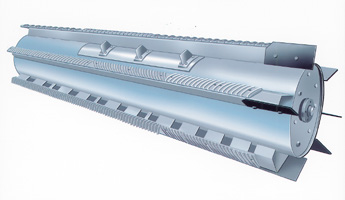
Features
Seed & Chemical
Seed Treatment
Combating Asian soybean rust
A soybean virus is being used to help identify resistance genes against Asian soybean rust and other soybean pathogens. Using this technology, called virus-induced gene silencing (VIGS), researchers stop the function of selected soybean genes to see if they are involved in resistance to a specific disease.
September 30, 2009 By Heather Hager

|
|
| Asian soybean rust destroys photosynthetic tissue and can lead to serious yield losses. Photo courtesy of United States Department of Agriculture-Agricultural Research Service. |
A soybean virus is being used to help identify resistance genes against Asian soybean rust and other soybean pathogens. Using this technology, called virus-induced gene silencing (VIGS), researchers stop the function of selected soybean genes to see if they are involved in resistance to a specific disease. Once located and identified, the resistance genes can be used in breeding programs or biotechnology to develop disease-resistant soybean varieties.
In soybeans, the VIGS technology uses bean pod mottle virus to silence genes. When the virus replicates in the soybean plant, it produces double-stranded RNA (ribonucleic acid), rather than DNA
(deoxyribonucleic acid), as its genetic material. “Plants recognize the foreign
viral double-stranded RNA and try to chop sit up to limit the infection,” explains Dr. Kerry Pedley, molecular biologist with the United States Department of Agriculture’s Agricultural Research Service (USDA-ARS) in Fort Detrick, Maryland. “We can take advantage of this response by putting a little piece of a plant gene of interest into the virus. When the plant starts chopping up the virus, it also chops up the plant gene. It essentially tricks the plant into turning off any gene of its own that we insert into the virus.”
To pinpoint genes involved in resistance to Asian soybean rust, Pedley takes a rust-resistant soybean plant, uses VIGS to stop the functioning of a suspected resistance gene, exposes the plant to the rust fungus, and then examines the plant’s response. “If the gene that we turn off plays a critical role in the resistance response, the resistant plant should become a susceptible plant after gene silencing.” After further analysis and verification, the gene can be used in soybean breeding programs.
Pedley is one of seven collaborators who are involved in a project led by Dr. Steve Whitham, a plant pathologist and associate professor at Iowa State University. In October 2008, Whitham and his collaborators, who hail from both the United States and Brazil, received a $2.1 million (US) grant from the United States’ National Science Foundation to study soybean resistance against Asian soybean rust, soybean cyst nematode and soybean mosaic virus.
 |
|
| This photo of a Brazilian soybean field (top) shows the severe discolouration that precedes the advanced and then complete defoliation (below) that occurs with Asian soybean rust. | |
 |
Which genes to silence?
With an estimated 66,000 genes in the soybean genome, the first step in gene silencing is to narrow down which areas of the genome contain candidate resistance genes. Brazilian researchers have developed markers that indicate the regions of the genome that contain rust resistance genes, a process called mapping. “Mapping is like going to the library to look for a specific book and the librarian tells you what shelf it’s on. You still have to look through all the books on that shelf, but at least you don’t have to look through the whole library,” explains Dr. Michelle Graham, a USDA-ARS geneticist at Iowa State University who is working on two of the mapped resistance genes against Asian soybean rust.
Graham uses the markers mapped by her Brazilian colleagues to isolate regions of DNA that contain the resistance genes. She then determines the complete genetic code for each region and picks out the genes that resemble known resistance genes. She gives the genetic code information for the suspected resistance genes to Pedley and Whitham, who insert it into bean pod mottle virus, and use VIGS to determine whether each suspected gene is actually involved in the plant’s resistance response.
A resistance gene is often found clustered in a row with other related copies, and the number and sequence of copies in the cluster can affect the strength of resistance, says Graham. She is working on Rpp4, which is one of five currently mapped Asian soybean rust resistance genes that are found at different locations in the genome. “For Rpp4, we think that there are five copies clustered together in the resistant parent, but only three in the susceptible parent,” she says. The researchers have used VIGS to determine that one of the candidate genes confers resistance. Further experiments are underway to determine why the three-copy combination does not work like the five-copy one; for example, the gene might not turn on at the right time or it might not recognize the rust pathogen.
The advantages of VIGS are numerous. “The nice thing about VIGS is that it gives you a fast way to test the genes’ function,” says Graham. Prior to the development of VIGS, this step would take at least 10 months in soybeans; with VIGS, it takes only six to eight weeks. And because VIGS is less expensive than the traditional method, many more genes can be tested. “Once you’re confident that you’re on the right track, you can go into more expensive methods for confirmation,” says Graham. “Also, by narrowing down the gene, we can make better markers for it that can be used by breeders.”
Soybean breeding applications
Unfortunately, each of the five mapped Asian soybean rust resistance genes does not confer resistance to all races of the fungus, says Pedley. “One of the hopes is that by using this method to identify the resistance genes, the breeders will know what they are and then can combine them or stack them together in the same variety. That would expand resistance to more fungal races.”
However, it will be a while before soybean growers will be able to reap the benefits of this research. “For us to confirm that we have the right gene and some associated markers will take one to two years,” predicts Graham. Soybean breeders could then use the specific markers in breeding programs to bring the gene into elite germplasm, with the object of creating Asian soybean rust-resistant varieties that maintain good yields. That process could take anywhere from five to 10 years, or more.
There is also potential to identify genes that are not directly involved in recognizing the races of the pathogen, but that are still involved in producing the resistance response. “Upstream in the signalling pathway is the resistance gene itself, like Rpp4, that recognizes the presence of the pathogen,” explains Whitham. “Downstream, you have all the other genes that are needed once the resistance gene is activated. These genes actually lead to the resistance response that restricts the growth of the pathogen.” He says that work in model plants like Arabidopsis and tobacco has shown that the downstream genes are often the same for different pathogens.
“The actual resistance genes give you specificity for the pathogen or different races of a pathogen, and then those feed into a common (shared) downstream signalling pathway.
Normally, the downstream genes are off (nonfunctioning) in the absence of a pathogen. In the presence of the pathogen, they get turned on and activate the plant’s defences,” says Whitham. Eventually, it might be possible to breed a plant that always has the downstream genes turned on, giving it a constant, more resistant state, or the genes could be superactivated when turned on to increase the resistance response.